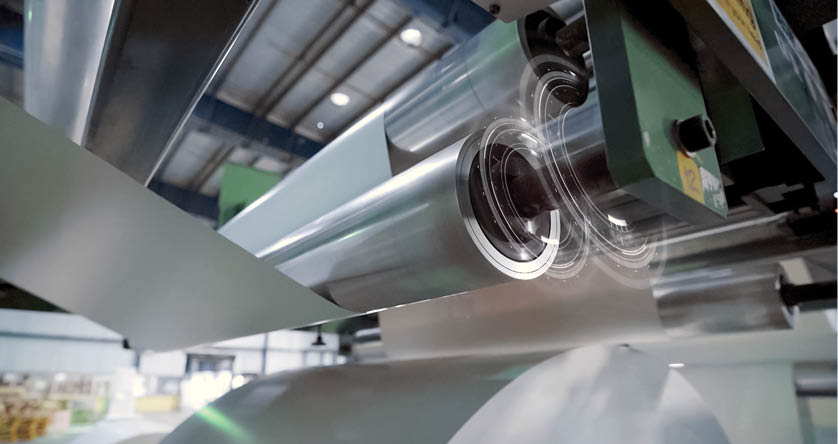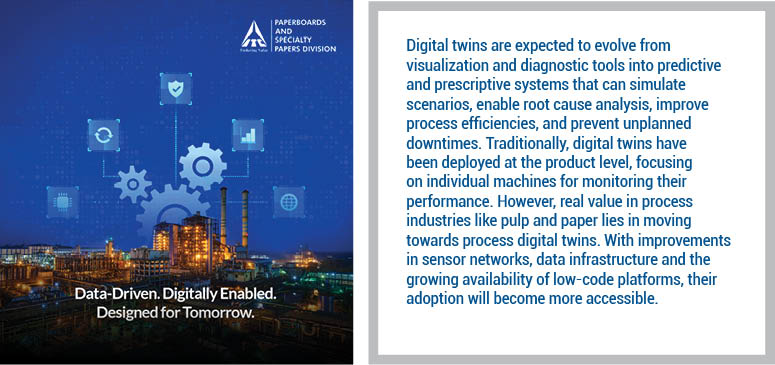Digital twins can help the paper industry in achieving greater visibility, control and predictability in operations. In an exclusive conversation with Paper Mart, Mr. Gaurav Kataria, VP Digital (Manufacturing) and Chief Digital and Information Officer (CDIO) at ITC PSPD, explains how the company has successfully developed its in-house digital twin technology using Python and Tkinter demonstrating that effective solutions can be built without depending solely on costly proprietary platforms.

Paper Mart: What role does digital twin technology play in paper industry operations today?
Gaurav Kataria: Digital twin technology is emerging as a powerful enabler in the paper industry since it offers real-time visibility and control over complex processes. It enables mills to create real-time, virtual replicas of chemico-physical processes, helping visualize hidden parameters, simulate outcomes and optimize operations continuously.
Traditionally, digital twins have been deployed at the product level, focusing on individual machines or motors for monitoring their performance. However, real value in process industries like pulp and paper lies in moving towards process digital twins which can be integrated as real-time models that represent entire operational workflows rather than just single units. This shift from ‘a product to process’, digital twin technology allows mills to go beyond machine-level insights and capture and simulate behaviors of complex processes.
One of the most strategic areas for applying process digital twins are digesters which are the starting point of the pulp production line. This is where wood chips undergo chemical cooking to become pulp, and therefore, it’s the stage where maximum control can be exercised over the quality of the final product.
However, due to pulping being a complex multi-stage process, digesters are often difficult to monitor in real time, and often operate as a ‘black box’. Having an in-house digital twin in place for such a process, helps us move from reactive troubleshooting to real-time, data-driven decision making, leading to improvements in efficiency and quality across the entire value chain.
This mirrors broader industry trends, where 29% of manufacturing firms globally have implemented process digital twins, up from just 20% in 2020.
Watch: In Pursuit of Lesser Water Footprint
PM: How do you view the potential or readiness for digital twin applications in Indian paper mills?
GK: The readiness in Indian paper mills for digital twin adoption is growing, but it’s still in the early stages. While there’s increasing awareness of Industry 4.0 tools, implementations are often limited to isolated automation and dashboard monitoring.
However, our in-house success with a process digital twin, which was developed using Python and Tkinter demonstrates that effective digital twins can be built without depending solely on expensive proprietary platforms.
Such an approach would be more realistic and feasible for Indian paper mills. That being said, broader adoption will depend on strengthening certain foundational elements.
Real time digital twins require robust IoT infrastructure including smart sensors, data historians and reliable data connectivity which are still evolving in many mills. Just as important would be capability building to empower engineers, and operations teams with skills to extract, interpret, and act on data insights. Without this, even the most advanced digital systems would remain underutilized.
According to the India digital twin market report, the segment in India reached around USD 546.7 million in 2024 and is projected to grow at 41% CAGR to over USD 4.6 billion by 2030.

One of the most strategic areas for applying process digital twins are digesters which are the starting point of the pulp production line.

PM: What are the key benefits of implementing digital twins in terms of sustainability, cost reduction, and process optimization?
GK: Digital twins can help in achieving greater visibility, control and predictability in operations. By integrating real time data with simulation models, they allow mills to optimize resource usage, reduce variability and respond proactively to process deviations, all of which contribute to cost reduction and sustainability goals.
In areas like pulp cooking, chemical dosing or energy management, digital twins help uncover inefficiencies that might otherwise remain hidden. From a sustainability perspective, digital twins contribute by minimizing chemical overuse, optimizing steam and power loads and enabling better recovery of by-products. Additionally, they serve as decision- support tools for long term improvements.

29% of manufacturing firms globally have implemented process digital twins, up from just 20% in 2020.
PM: What are the challenges in adopting digital twin tech in paper mills?
GK: While digital twins hold great promise, their adoption in paper mills comes with several challenges. A key limitation is lack of domain specific models tailored to unique processes of pulp and paper manufacturing.
With GenAI adoption on the rise, the risk of hallucination and model inaccuracies is high and needs to be controlled. Most commercial solutions are generalized and require significant customization to even come close to reflecting the actual plant behavior.
Another major challenge is ensuring the digital twin can effectively handle the natural variability in raw material quality, which is often beyond mill’s control. For instance, changes in wood furnish properties such as species, moisture content, girth and age can significantly impact cooking efficiency and pulp quality. If the digital twin is not designed to adapt itself to these fluctuations, its predictive and optimization capabilities can become unreliable.
Additionally, digital infrastructure and data science skills need to catch up to support widespread and effective adoption.
Also Read: Kuantum Papers Reimagines Paper Manufacturing with Digital Twin Technology
PM: What do you see as the future of digital twin technology in the paper industry, especially in India?
GK: The future of digital twin technology in the paper industry, especially in India, is very promising. Globally, the digital twin market was valued at USD 10-11 billion in 2023, with a projected CAGR of 30-45% over the next several years. In India, the market stood at around USD 842.8 million in 2024, and is expected to grow nearly 20 times by 2033.
Pulp and paper mills are increasingly looking to optimize performance, reduce variability and improve sustainability. Digital twins are expected to evolve from visualization and diagnostic tools into predictive and prescriptive systems that can simulate scenarios, enable root cause analysis, improve process efficiencies, and prevent unplanned downtimes.

According to the India digital twin market report, the segment in India reached around USD 546.7 million in 2024 and is projected to grow at 41% CAGR to over USD 4.6 billion by 2030.
With improvements in sensor networks, data infrastructure and the growing availability of low-code platforms, their adoption will become more accessible.
Importantly, in future, digital twins will need to focus more on the quality of the AI/ML model which will need to be robust enough to handle raw material variability, adapting to the changes in demand and their ability to maintain predictive reliability.
As capability within mill teams grows, these tools will become central to data-driven decision making, continuous improvement and smarter process control, which would make them a vital part of the industry’s digital transformation journey.




